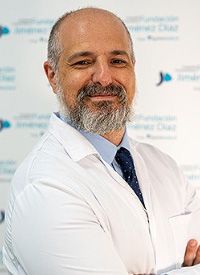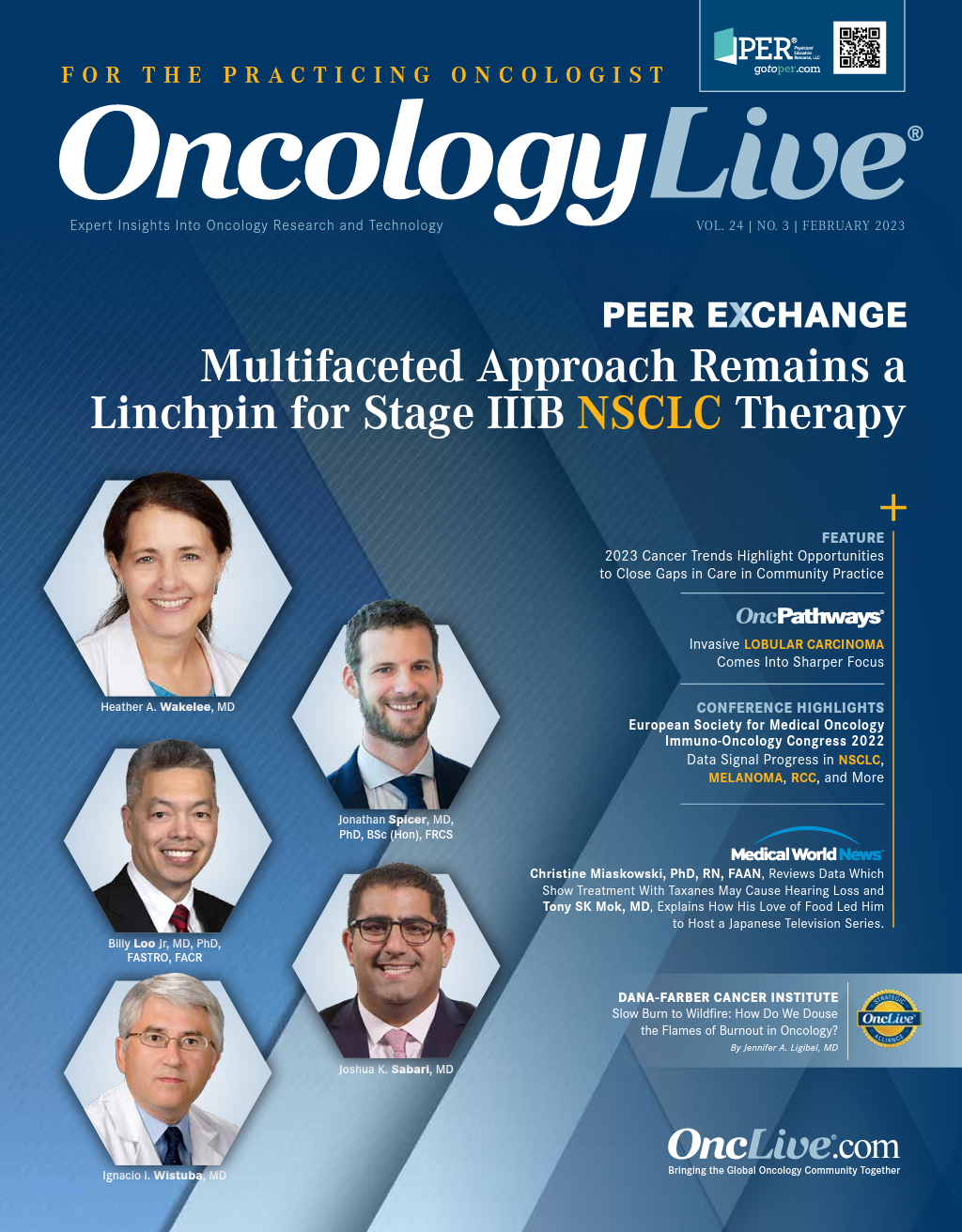Publication
Article
EPCORE Pushes CD3 × CD20 Bispecific Antibody Into Next Phase of Exploration in DLBCL
Author(s):
Advances in the development of bispecific antibodies have demonstrated response rates close to or surpassing those of other agents in development, offering investigators an avenue to pursue phase 3 studies such as EPCORE DLBCL-1 to challenge standard of care with the CD3 × CD20 agent, epcoritamab in diffuse large B-cell lymphoma.
Raúl Córdoba Mascuñano, MD, PhD

The response rates to agents available in the third or later lines of therapy for patients with relapsed or refractory diffuse large B-cell lymphoma (DLBCL) have improved significantly with the advent of chimeric antigen receptor (CAR) T-cell therapies such as lisocabtagene maraleucel (Breyanzi). However, alternative options are needed for patients who cannot access the therapy or who experience disease progression after receiving it.1-3
Advances in the development of bispecific antibodies have demonstrated response rates close to or surpassing those of other agents in development, offering investigators an avenue to pursue phase 3 studies such as EPCORE DLBCL-1 (NCT04628494) to challenge standard of care with the CD3 × CD20 agent, epcoritamab.1,4
Patients with high-risk DLBCL have a 5-year overall survival (OS) rate of 49% to 61% per varying criteria.1 “Relapsed Raúl Córdoba Mascuñano, MD, PhD or refractory DLBCL remains very difficult to treat. We can cure up to two-thirds of patients [with DLBCL], but one-third of patients cannot be cured when given frontline therapy with regimens such as R-CHOP [rituximab (Rituxan) plus cyclophosphamide, doxorubicin, vincristine, and prednisone],” Raúl Córdoba Mascuñano, MD, PhD, said in an interview with OncologyLive®. Up to 15% of patients treated who receive R-CHOP will have either an incomplete response or a relapse within 6 months of treatment. Nearly one-quarter of patients will relapse within in 2 years of R-CHOP.1
“It’s not easy to cure these patients who have relapsed disease,” said Córdoba Mascuñano, who is coordinator of the Lymphoma Unit at Jiménez Díaz Foundation University Hospital in Madrid, Span. “However, we have a second attempt to cure these patients when we offer second-line chemotherapy plus autologous stem cell transplant [ASCT].” Although ASCT provides the best option for patients to achieve cure, most patients are either ineligible for transplant or relapse after the procedure.
Reexamining the Standard of Care
Patients may not be candidates for ASCT for several reasons, including fitness, which takes into account age, comorbidities, and response to prior therapies.1 In those eligible for transplant, the cure rate is approximately 25% to 30%, with only half of patients responding to salvage therapy prior to transplant.
Palliative treatment options for patients who do not respond to therapy include bendamustine (Bendeka) plus rituximab or rituximab plus gemcitabine and oxaliplatin (R-GemOx). Additional treatments such as antibody-drug conjugates have response rates of up to 50% in phase 1 or phase 2 studies, whereas monoclonal antibodies have response rates of up to 60% in phase 2 studies. CAR T-cell therapies have the highest documented response (82%); however, the availability and cost of such therapies remain a barrier for patients.
Several bispecific antibodies are in development for patients with relapsed or refractory large B-cell lymphoma (LBCL) and are being evaluated in phase 1 or phase 2 studies. Blinatumomab, a bispecific T-cell engager, is designed to target CD19 and CD3 and has demonstrated a response rate of 43% among 19 evaluable patients.5 Like epcoritamab, mosunetuzumab, glofitamab, and odronextamab are engineered to target CD3 on T cells and CD20 on B cells, with response rates ranging between 32% and 42%.6-8
Bringing Epcoritamab Into Focus
Data from a dose-expansion cohort of the EPCORE NHL-1 study (NCT03625037) showed that among 157 individuals who received the CD3 × CD20 bispecific antibody, the overall response rate (ORR) was 63.1% (95% CI, 55.0%-70.6%) and the complete response (CR) rate, 38.9% (95% CI, 31.2%-46.9%). Responses lasted for a median of 1 year; the median duration of response (DOR) among those who achieved a CR was not reached. At 6 and 9 months, an estimated 88.7% of complete responders were reported as still deriving benefit from single-agent epcoritamab.9
The median time to any response and to CR was 1.4 months (range, 1.0-8.4) and 2.7 months (range, 1.2-11.1), respectively. Median progression-free survival (PFS), a secondary end point of the study, was 4.4 months (95% CI, 3.0-7.9) with a PFS rate of 43.9% (95% CI, 35.7%-51.7%) at 6 months. At the time of the analysis, median overall survival (OS) was not reached (95% CI, 11.3-NR).
Minimal residual disease (MRD), a marker under exploration with greater focus in LBCL, was an exploratory objective in the study and was evaluable in 107 patients. MRD-negativity was observed in 45.8% (95% CI, 36.1%-55.7%) of patients and the 6-month MRD-negativity rate was estimated at 78.7%. In an analysis of outcomes by MRD-negativity, investigators reported that PFS was longer than the general population in those with MRD-negative status.9
Most patients enrolled in the study had DLBCL (88.5%). Other CD20-positive mature B-cell neoplasms included primary mediastinal LBCL (n = 4; 2.5%), follicular lymphoma (n = 5; 3.2%), and high-grade B-cell lymphoma not otherwise specified (n = 9; 5.7%). Patients received a median of 5 cycles of treatment (range, 1-20), equating to 15 doses. At data cutoff, 32.5% of patients remained on treatment.
Ninety-six patients had primary refractory disease at baseline. The ORR among this subgroup was 55.2%, with a CR rate of 30.2%. Prior to enrollment, 61 patients received CAR T-cell therapy (38.9%). More than half of patients had a response (54.1%), and 34.4% of responders had a CR. The median DOR was 9.7 months (95% CI, 5.4-NR). For patients who did not receive prior CAR T-cell therapy the ORR was 68.8% with a CR rate of 41.7%, and the median DOR was NR.9
A safety analysis showed that grade 3 or higher treatment emergent adverse effects (TEAEs) were reported among 61.6% of patients, resulting in 11 patients discontinuing treatment. The most common grade 3 or higher TEAEs included neutropenia (14.6%), anemia (10.2%), thrombocytopenia (5.7%), and cytokine release syndrome (CRS; 2.5%). Any-grade CRS occurred in 49.7% of patients on study, and the median time to resolution was 2 days. AEs of interest included immune effector cell–associated neurotoxicity syndrome (ICANS), which occurred in 6.4% of patients, with 1 patient experiencing a grade 3 or higher event. Clinical tumor lysis syndrome was document in 2 patients and both events were grade 3 or higher in severity.
Twelve patients discontinued treatment due to TEAEs, with CRS and ICANS attributed to 1 patient each. Nine patients died on study and investigators reported that no grade 5 events were attributed to epcoritamab.9
Based on data from this study the FDA accepted a biologics license application for epcoritamab for adult patients with relapsed or refractory LBCL who have received 2 or more prior lines of therapy.10
Additional studies have been undertaken with epcoritamab for patients with DLBCL ineligible for ASCT, specifically in combination with GemOx in arm 5 of the phase 1/2 EPCORE NHL-2 trial (NCT04663347).11
At a data cutoff of December 2021, 27 patients with a median age of 71 years (range, 47-87) received epcoritamab plus GemOx. The median number of prior therapies for this population was 2 (range, 1-13) and more than half of patients (59%) remained on treatment at the time of analysis.
Two patients died within 60 days of the first dose and were not evaluable for response. ORR for this cohort of patients was 92% with a complete metabolic response rate of 60% and a partial metabolic response rate of 32%. The longest duration of response was 6.9 months.11
In terms of safety, 4 patients died on treatment and investigators noted that no deaths were attributed to epcoritamab. The most common TEAEs were CRS (70%), thrombocytopenia (70%), and neutropenia (56%). Most cases of CRS occurred in cycle 1, were grade 1 or grade 2 in severity, and had a median time to resolution of 2 days. No patients discontinued treatment due to CRS. Of note, 3 patients had received prior CAR T-cell therapy and all remained on treatment in response.11
Challenging Investigator's Choice
EPCORE DLBCL-1 will further explore singleagent epcoritamab against standard-of-care chemotherapy of investigator’s choice among patients with relapsed or refractory DLBCL who were either ineligible for or did not respond to treatment with ASCT (Figure).4 The primary efficacy measure is OS, with secondary outcomes of PFS, ORR, CR, DOR, time to response, and rate and duration of MRD negativity, which will be determined as having at least 1 negative MRD sample at any time prior to the start of subsequent antilymphoma therapy.4
CD20-positive disease must be identified among those with DLBCL not otherwise specified, including de novo or follicular lymphoma that was histologically transformed, double- or triple-hit DLBCL, grade 3B follicular lymphoma, T-cell LBCL, or histiocyte-rich LBCL. Patients must have an ECOG performance status of 0 to 2 and acceptable liver and renal function as well as an anticipated life expectancy of more than 2 months on standard-of-care chemotherapy. Of note, patients with primary central nervous system tumors are not eligible for this trial. Prior treatment with a CD3 × CD20 bispecific antibody is not permitted.4
Epcoritamab will be administered as a subcutaneous injection following required premedication, which include step-up dosing and corticosteroid prophylaxis during the first cycle to mitigate CRS. Investigator choice chemotherapy options include either bendamustine plus rituximab or R-GemOx.
The trial is open for enrollment.
References
- Shen LH, Salles G. Diffuse large B-cell lymphoma. N Engl J Med. 2021;384(9):842-858. doi:10.1056/NEJMra2027612
- Shah H, Stephens D, Seymour J, Maddocks K. Incorporating novel targeted and immunotherapeutic agents in the treatment of B-cell lymphomas. Am Soc Clin Oncol Educ Book. 2021;41:1-18. doi:10.1200/EDBK_320117
- FDA approves lisocabtagene maraleucel for relapsed or refractory large B-cell lymphoma. FDA. February 5, 2021. Accessed January 18, 2023. bit.ly/31ALyIj
- A phase 3 trial of epcoritamab vs investigator’s choice chemotherapy in R/R DLBCL (EPCORE DLBCL-1). ClinicalTrials.gov. Updated January 11, 2023. Accessed January 20, 2023. https:// clinicaltrials.gov/ct2/show/NCT04628494
- Viardot A, Goebeler ME, Hess G, et al. Phase 2 study of the bispecific T-cell engager (BiTE) antibody blinatumomab in relapsed/refractory diffuse large B-cell lymphoma. Blood. 2016;127(11):1410-1416. doi:10.1182/blood-2015-06-651380
- Schuster SJ, Bartlett NL, Assouline S, et al. Mosunetuzumab induces complete remissions in poor prognosis non-Hodgkin lymphoma patients, including those who are resistant to or relapsing after chimeric antigen receptor T-cell (CAR-T) therapies, and is active in treatment through multiple lines. Blood. 2019;134(suppl 1):6. doi:10.1182/blood-2019-123742
- Hutchings M, Morschhauser F, Iacoboni G, et al. Glofitamab, a novel, bivalent CD20-targeting T-cell-engaging bispecific antibody, induces durable complete remissions in relapsed or refractory B-cell lymphoma: a phase I trial. J Clin Oncol. 2021;39(18):19591970. doi:10.1200/JCO.20.03175
- Bannerji R, Arnason JE, Advani RH, et al. Odronextamab, a human CD20×CD3 bispecific antibody in patients with CD20-positive B-cell malignancies (ELM-1): results from the relapsed or refractory non-Hodgkin lymphoma cohort in a single-arm, multicentre, phase 1 trial. Lancet Haematol. 2022;9(5):e327-e339. doi:10.1016/S2352-3026(22)00072-2
- Thieblemont C, Phillips T, Ghesquieres H, et al. Epcoritamab, a novel, subcutaneous CD3xCD20 bispecific T-cell–engaging antibody, in relapsed or refractory large B-cell lymphoma: dose expansion in a phase I/II trial. J Clin Oncol. Published online December 22, 2022. doi:10.1200/JCO.22.01725
- U.S. FDA accepts for priority review the biologics license application for epcoritamab (DuoBody-CD3xCD20) for the treatment of relapsed/refractory large B-cell lymphoma. News release. AbbVie. November 21, 2022. Accessed January 20, 2023. bit.ly/3D3EIuD
- Wahlin BE, Brody J, Phillips T, et al. Subcutaneous epcoritamab with GemOx induced high response rates in patients with relapsed/refractory diffuse large B-cell lymphoma ineligible for autologous stem cell transplant. HemaSphere. 2022;6:10991100. doi:10.1097/01.HS9.0000847716.29326.a8










